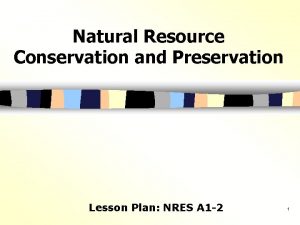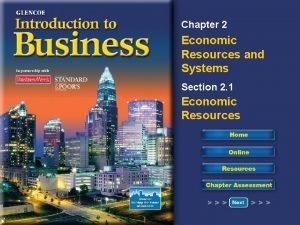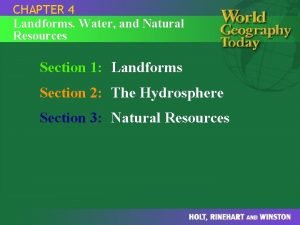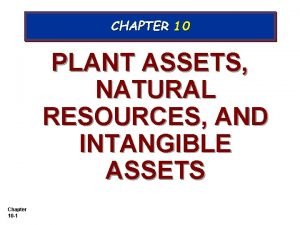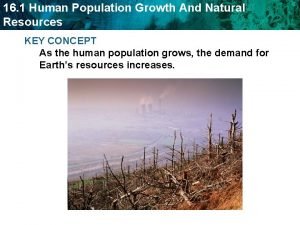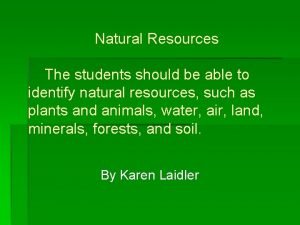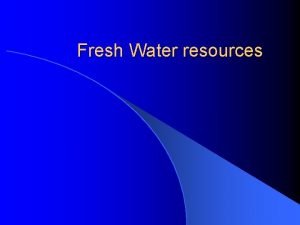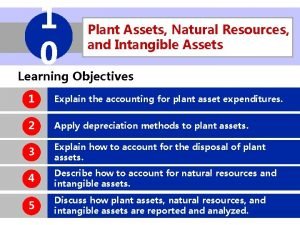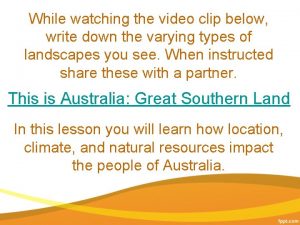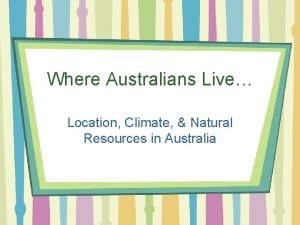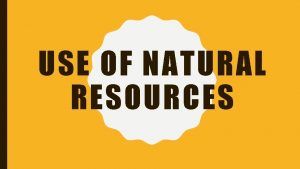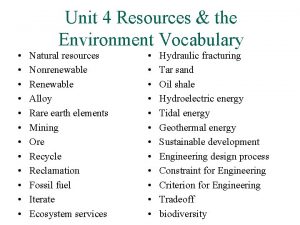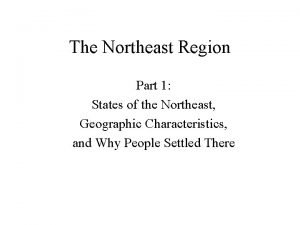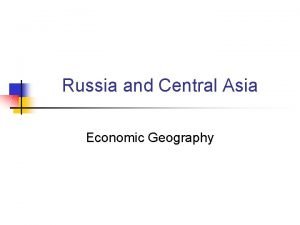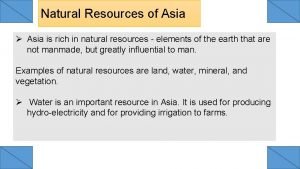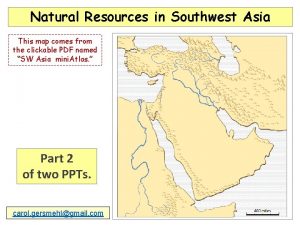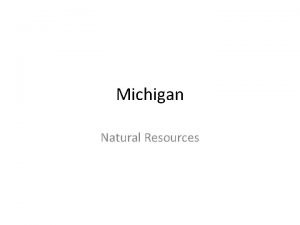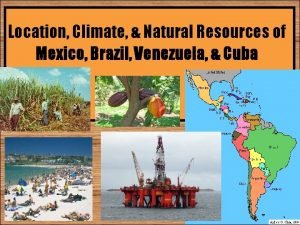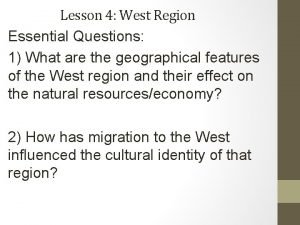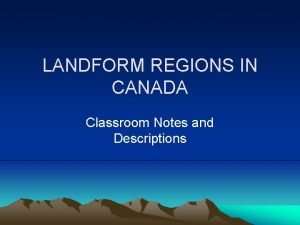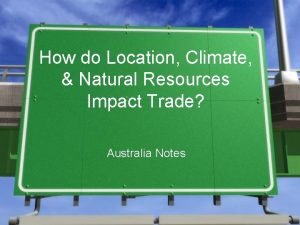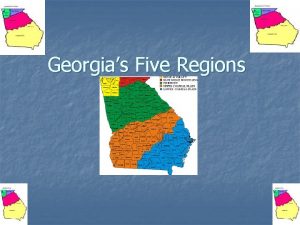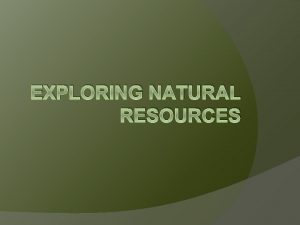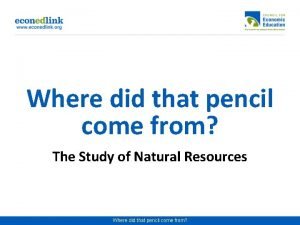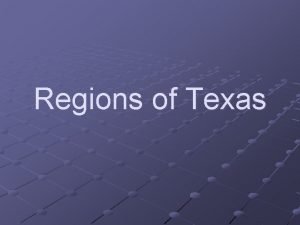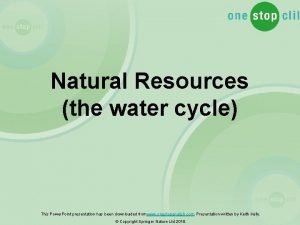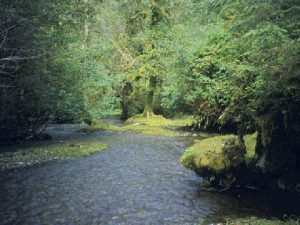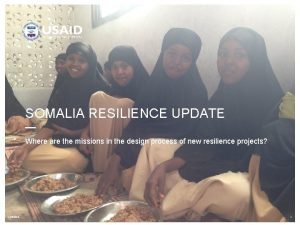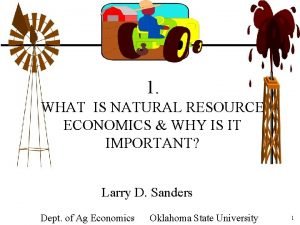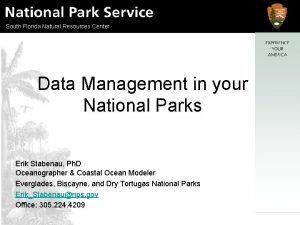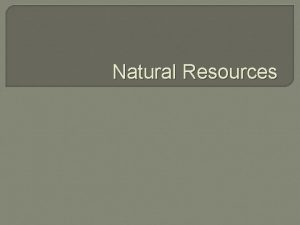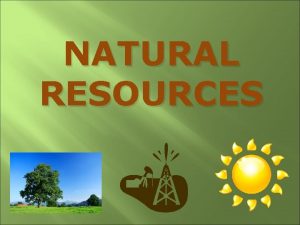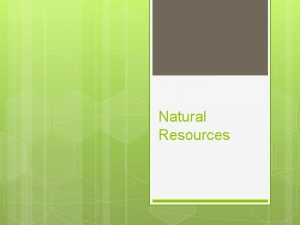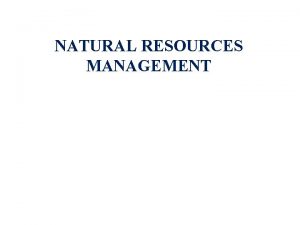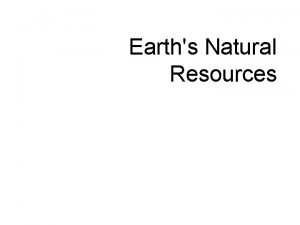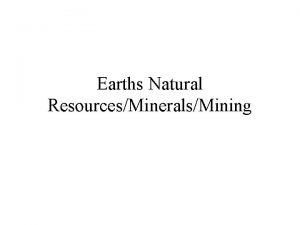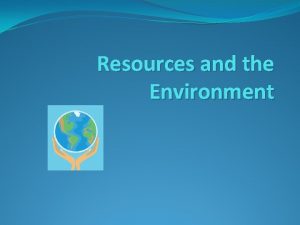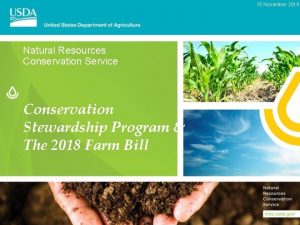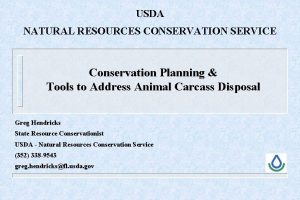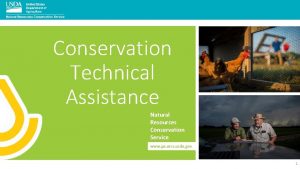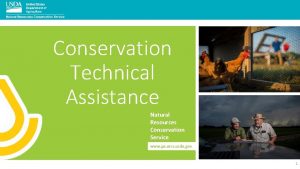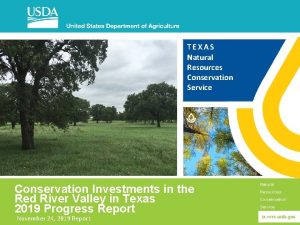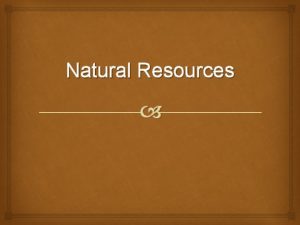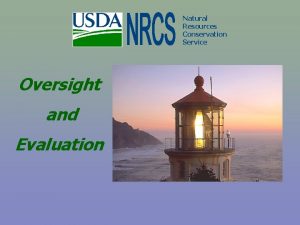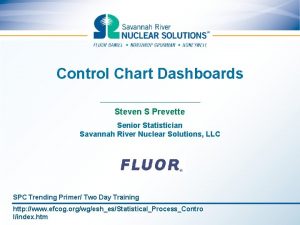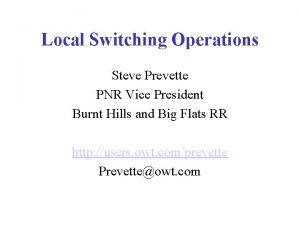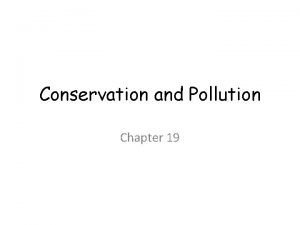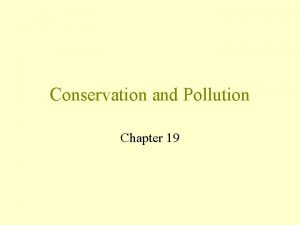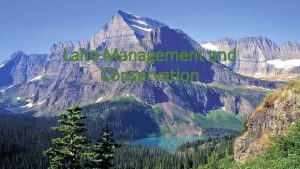Resources Conservation and Management Mr Prevette Natural Resources












































- Slides: 44

Resources, Conservation, and Management Mr. Prevette

Natural Resources • Items found about the earth that humans use as fuel, food, shelter, or a source of wealth • Examples? • Oil, coal, water, minerals, arable land, wildlife, forests • Without these resources, we would be without various necessities/luxuries

Just Imagine • • • A life without modes of transportation Electricity Running Water Supermarkets full of food How do the resources we discussed play a key role in our way of life?

Early Ancestors • • • Human life impossible without water Most people situated themselves around water Began to use wildlife and wild plants for food Transitioned from hunter/gathers to farmers Utilized more and more natural resources Today, are we more or less dependent on our natural resources?

Renewable or Nonrenewable? • Nonrenewable- mineral resources such as iron, copper, lead, uranium, and aluminum Fossil fuels such as oil, coal, and natural gas Once available supply has been used, cannot be replaced • Renewable- with care and management, can be used indefinitely Forests, wildlife, water, and soil • Can be abused, How?

Natural Resources in America’s Development • • #1 Resource people were looking for in America? Land Short supply in Europe- Why? Were able to use wildlife, timber, and land as resources for development and wealth • 90% of settlers were farmers

Early Settlers • Were searching for valuables such as gold, silver, and precious jewels • Instead, found a rich land full of wildlife, forests, and inhabited land • Settlers found the English couldn’t get enough furs and hides (Used for hats, gloves, coats, and other leather goods) • Moved into western Pennsylvania, Ohio, and the Tennessee Valley • Found rich, deep soil, abundance of fur and meat bearing wildlife

Common Settler Practices • • Clear cut a piece of land Use the timber to build a cabin Plant crops on the cleared ground Use wildlife as a source for food Exhaust a plot a land Start again Northeastern soil not as fertile, began to move west (Slash and Burn)

Moving West • 1849 - first major gold deposits were found in California • Farmers began to rush west with their families in hopes of becoming rich • What happened? • We know that thousands perished in the Great Plains due to the following reasons: Thirst, hunger, cold, hostile Indians, disease, and poor planning • Ironically, Great Plains were skipped over in search for “promised” wealth

Conquering the Plains • Invention of the steel plow and Russian wheat made the Plains tolerable • Plows would break up the sod, windmills supplied water • Internal combustion engine led to the oil rush • The need for oil drove explorers to Texas, Oklahoma, and Louisiana • Led to the production of oil, fuels, plastics, chemicals, tires, etc

We Know… • • • We are more dependent on natural resources as a society Less dependent on wildlife Why? Why is wildlife management important Wildlife has an aesthetic value…. it is different for everyone.

Economic Impact • • Hunting is more of a sport then a necessity now 15 million hunters $950 million generated in license fees yearly Excise taxes on firearms, ammunition, and archery equipment contribute ____ yearly • Economic contributions of $6 billion dollars yearly • In some rural communities, hunting is the major source of income

Resource Map • Select 2 nonrenewable resources we discussed in class and explain the major uses of each. Then, select 2 renewable resources and explain their uses. Finally, provide examples of how renewable and now resources are used to work together.

Conservation Overview • Natural resources are the most important things we have • Important to conserve them for future generations • Coal, oil, natural gas, and water will remain our current sources of power • Forests will continue to provide our building materials • Soil will grow our crops • Implementation of alternative substitutes are imperative

Soil Conservation • Became important after the Dust Bowl and Great Depression (1930 s) • Erosion is the most serious threat to soil 1. Water erosion- runoff and raindrops striking the ground • Raindrops travel at 20 -25 mph, and billions come down in every summer shower • Takes the path of least resistance • Muddy ditches…. a sign of water erosion

Soil Conservation Cont. 2. Wind erosion- the wind picks up soil particles and moves them to another location • Sand other particles can become very abrasive when carried by the wind • Young plants can be cut off at the ground • Soil particles almost become missiles • Dust Bowl could be seen from New Yorl

Soils Cont. • Soil Conservation Service- formed in 1935 and educated about preserving soils, especially topsoil • Examples of soil management practices: 1. Shelter belts- tree planted in lines to break up wind 2. No till farming 3. Contour plowing

Conservation Reserve Program • Land that received too little rainfall sat aside and planted in grasses, trees, and shrubs • Set aside for 10 years • Marginal farmland is starting to come out of CRP…. why? • The millions of acres of land that was set aside, and still is, has prevented soil erosion and created habitat for wildlife



Forest Conservation • • • One of our greatest resources Nearly all of the Eastern US was forest Currently 738 million acres left, 70% of what we had in 1500 Uses of wood: Furniture, Boxes, Framing, Cabinets, Flooring, Fencing Materials, Railroad Ties, Telephone Poles, Plywood, etc • What are converted wood products?

Forest Conservation Cont. • Converted wood products- chemically or mechanically altered • Paper, Charcoal, Plastics, and Explosives • Reforestation- the planted of trees on previously harvested land • Lumber companies must do a better job replanting trees to keep up with the amount of forests we are losing

Wildlife Conservation • Some species are now in greater numbers than during colonial times • • Will constantly have to fight encroachment Encroachment- trespassing or advancing beyond proper limits Wildlife continue to lose habitat due to encroachment of humans We must work to re-establish wildlife habitats to ensure their survival

Fossil Fuel Conservation • Oil, natural gas, and coal were abused until the 1960’s • Thought we had oil to burn, literally • Organization of Petroleum Exporting Countries (OPEC)- formed in 1960 by Persian Gulf states and Venezuela • Formed to halt decreasing oil prices by 7 largest oil companies • Arab-Israeli War 1973 - Arab oil producing countries cut back production and stopped shipments to the US, which limited supplies

Fossil Fuel Conservation Cont. • • Fuel prices doubled in the US Cars that got 8 -10 mpg were no longer efficient to drive Japanese entered the American car market offering smaller vehicles 55 mph speed limit was born…. Why? Fuel efficiency goals were set by the government for automakers to meet Propane and natural gas became common fuels for smaller applications Amount of oil we use still increases, but at a slower rate Alternative energy sources and improved fuel economy, insulation, A/C and heating

Mineral Conservation • • • Not as pressing as fossil fuels Conservation is still needed because there is only so much supply Recycling has been practiced for years Example of recycling minerals? Scrap iron, mainly steel, is becoming a common recyclable Aluminum can- manufacturer’s realized it was cheaper to recycle than replace

Water Conservation • • • Essential for all living organisms 70% of Earth covered in water, however 97% is salt water Half of our available 3% is frozen in glaciers and ice caps Desalination- converting salt water to fresh water (very expensive) Water was mistreated for years, because it was taken for granted Rivers, streams, and lakes were often pumped full of untreated waste

Numbers to Think About • 100 million gallons/ day (consumed by Americans) • 40 billion gallons/ day (consumed by Agriculture industry) • 2. 5 billion gallons are actually lost, the rest is returned to be used again • Every person uses approximately 150 gallons/ day (in the US) • Various industries use water each day to make products (ie paper, factory products)

Water Cont. • Irrigation- moving water from a source to be distributed on crops • Irrigation wells have caused the water table to lower • Aquifer’s, large underground lakes, are relied on to supply some major cities (San Antonio, TX) • What all do we use water for? • Bathing, cooking, cleaning, carrying away wastes (shower uses 5 gallons/min) • Other activities such as washing our cars, watering lawns, and bathing pets

Assignment • Karaoke Moment • Students will divide into groups and write a rap, song, or jingle to convey the information they are assigned. Once the groups have composed their tune, they will perform them for the class.

Administration of Management • Numerous agencies play a role in management on a federal and local level • • • US Fish and Wildlife Service US Department of Agriculture Bureau of Land Management US Forest Service State Fish and Wildlife Departments

US Fish and Wildlife Service • Mission- conserve, protect, and enhance fish and wildlife and their habitats for the continuing benefit of the American people. • Chartered in 1871 under the US Fish Commission (study decrease in food fish) • Fish and Wildlife Act 1956 - formally changed the name to what we know • https: //www. youtube. com/watch? v=of. ARYgeyi 6 g

Responsibilities Protecting and Enhancing: Maintains and Facilitates 1. 2. 3. 4. 5. 6. Migratory Birds Endangered Species Freshwater fisheries Anadromous fisheries (huh? ) Marine mammals Law enforcement agents Research labs Wildlife refuges Fish hatcheries 7 regional offices Headquarters in Washington DC

Endangered Species • Fish and Wildlife Service are responsible for this list’s protection • Works to identify plants and animals that are/could become threatened • Endangered Species Act- led to the development of the “List of Endangered and Threatened Wildlife and Plants” • Agency works with universities to incorporate recovery plans: habitat preservation and management, research, captive breeding, law enforcement

Success Stories • Alligators were once in danger of becoming extinct, but intensive efforts have almost led them to become pests in southern states • Bald eagles suffered from DDT usage (400 pairs at one point) • Manatee, California Condor, Red Wolf, Kemp’s Ridley sea turtle are still in grave danger • https: //www. youtube. com/watch? v=Doj. GPBV 4 U 0 w

National Wildlife Refuges • First refuge created in 1903 by Theodore Roosevelt (Pelican Island, FL) • Supervised by the US Fish and Wildlife Service • Numerous refuges throughout the united states (acres to thousand square miles) • Some established to protect large mammals (LBL), most migratory birds • US has established treaties with numerous countries to protect migratory birds that come to refuges to raise their young • https: //www. youtube. com/watch? v=4 yy. MEoq. G 0 j. A

Migratory Birds • https: //www. youtube. com/watch? v=4 yy. MEoq. G 0 j. A • • Bird Banding US Fish and Wildlife Service bands 1, 000 birds each year Study migratory patterns, age, species, gender https: //www. youtube. com/watch? v=qa. A 9 z. OW 3 FQ 4

Fisheries • Managed by the US Fish and Wildlife Service • How do we lose fish? (pollution, habitat damage, over harvesting) • Focus on 4 main species: 1. Pacific Northwest Salmon 2. Striped Bass of Chesapeake Bay 3. Atlantic Salmon 4. Great Lakes Trout

Fisheries Cont. • • 70 national fish hatcheries Provide 160 million fish yearly 50 species https: //www. youtube. com/watch? v=KGn 3 Pp. Kfm. U 0

Habitat Protection and Research • US Fish and Wildlife Service continues to make recommendation of how to complete projects without compromising wildlife habitat • Research is constantly completed to figure out the impacts of chemicals, pesticides, heavy metals, and other pollutants on wildlife • Partners with universities to train wildlife biologists to conduct research • https: //www. youtube. com/watch? v=g. VRCRMkzm. EA

Law Enforcement • US Fish and Wildlife Service is charged with enforcing federal laws • Enforce laws in regard to exportation and importation of wildlife and wildlife products • Carriers out international laws agreed upon by international treaties • Employs over 200 special agents and inspectors • https: //www. youtube. com/watch? v=-u. Weh. LB 0 A 8 I

US Forest Service • • • Manages around 190 million acres of public forests Provides habitat to numerous fish and wildlife Practices reforestation and building living structures for wildlife (nest boxes and fish passages) https: //www. youtube. com/watch? v=g. M-DZup. Ql. GM

Bureau of Land Management • Manages 270 million acres of public land • Focuses on nongame migratory birds • Established the Nongame Migratory Bird Habitat Conservation Strategy Plan • Restores wetland areas in bogs, marshes, estuaries • Develops and maintains numerous wetland projects each year • https: //www. youtube. com/watch? v=gdal. YBS 1 l. PE

US Department of Agriculture • Important to wildlife by the establishment of the Conservation Reserve Program (CRP) • Set aside land has provided a habitat for numerous wildlife • Prevented soil erosion and created habitat at the same time • https: //www. youtube. com/watch? v=9 Wj. Oj. MYb 7 EM
 Lesson plan on conservation of natural resources
Lesson plan on conservation of natural resources Environment management tool
Environment management tool Natural capital and natural income
Natural capital and natural income Plant assets are
Plant assets are Some natural resources such as wheat and cattle are
Some natural resources such as wheat and cattle are Landforms and natural resources
Landforms and natural resources Chapter 4 landforms water and natural resources
Chapter 4 landforms water and natural resources Accumulated depreciation straight line method
Accumulated depreciation straight line method Natural resources and population growth
Natural resources and population growth Natural resources and uses
Natural resources and uses Problems of water resources
Problems of water resources Agriculture and natural resources abbreviation
Agriculture and natural resources abbreviation Plant assets, natural resources, and intangible assets
Plant assets, natural resources, and intangible assets The transformation process
The transformation process Fixed resources and variable resources
Fixed resources and variable resources Natural hazards vs natural disasters
Natural hazards vs natural disasters Australia major natural resources
Australia major natural resources Climate of australia
Climate of australia What are the 4 types of natural resources
What are the 4 types of natural resources Natural resources vocabulary
Natural resources vocabulary Northeast physical characteristics
Northeast physical characteristics Map of russia natural resources
Map of russia natural resources Natural resources in southeast asia
Natural resources in southeast asia How would you describe this
How would you describe this Natural resources found in michigan
Natural resources found in michigan What are cuba's natural resources
What are cuba's natural resources West region natural resources
West region natural resources What landform region is yukon in
What landform region is yukon in Australia natural resources
Australia natural resources The climate in the coastal plains region
The climate in the coastal plains region Explain natural resources
Explain natural resources Japan major natural resources
Japan major natural resources Japan natural resources
Japan natural resources Japan natural resources
Japan natural resources Pencil natural resources
Pencil natural resources Coastal plains region of texas
Coastal plains region of texas Natural resources water cycle
Natural resources water cycle Inexhaustible resources
Inexhaustible resources Natural resources in northern europe
Natural resources in northern europe Somalia natural resources
Somalia natural resources Non storable resources
Non storable resources Natural resources
Natural resources South florida natural resources center
South florida natural resources center Northwest coast natural resources
Northwest coast natural resources Economy of indus valley civilization
Economy of indus valley civilization
